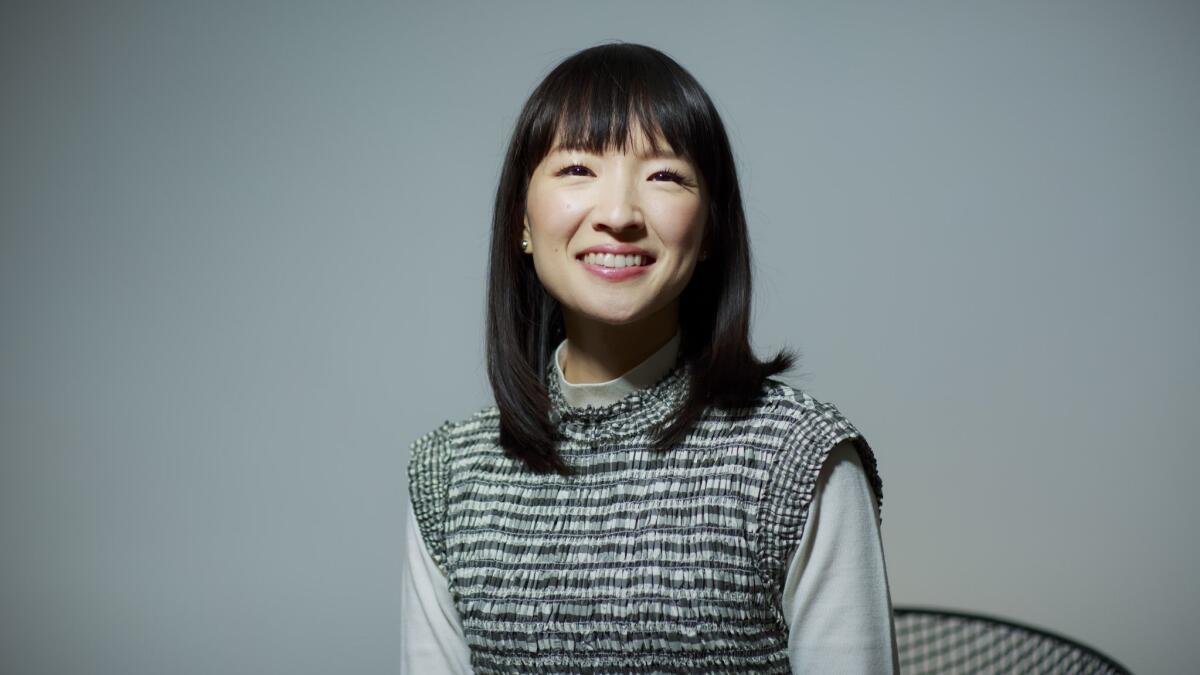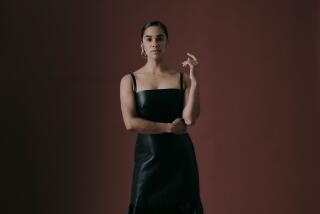Marie Kondo is proud of your tidying up, and wants to clarify that part about books

- Share via
Marie Kondo has seen your efforts. The Mt. Everest-sized heap of clothes that’s taken over your bed, the drawers of T-shirts freshly folded into compact tents neatly lined upright, that once-chaotic kitchen pantry that now looks ready for its debut in the pages of “Real Simple” magazine.
The de-cluttering guru, whose organizational philosophy has been drawing attention across the globe since 2011 with her bestselling books, including “The Life-Changing Magic of Tidying Up,” has reached a new level of influence and notoriety — and criticism — since the recent launch of her home makeover show for Netflix, now streaming in 190 countries.
With the debut of “Tidying Up With Marie Kondo,” cleverly released on Jan. 1 for those seeking a reset in the new year, the Japanese author has quickly emerged as a cultural and social media sensation. She has motivated a legion of viewers to watch her Netflix series and clean — good luck trying to evade the before-and-after photos of newly organized closets and sock drawers on Instagram. All the buzz has elevated Kondo to meme-level celebrity, the modern marker of relevancy. Her “spark joy” concept even made the rounds on posters at last week’s third-annual women’s march events across the country.
“My team has shared a great many photos and memes with me so I’ve seen them,” Kondo, 34, says through her interpreter, Marie Iida, who has become a celebrity in her own right since appearing on the show.
“I’m very surprised by the very huge reaction that the show garnered,” Kondo adds, “but what makes me especially happy is that so many people who watch the show have implemented the KonMari method of tidying.”
A hallmark of that method, for the uninitiated, can be summed up as such: Keep items that, when held, “spark joy”— a concept she designed to help determine which things you want to carry into your future. The items that don’t spark joy should be thanked and discarded. It’s a concept repeated time and again in the series as Kondo helps American families find the joy in tidying.
By now, everyone wants to roam the aisles of the Container Store with Kondo or get a peek inside her Los Angeles home, which she moved into last fall and shares with her husband and two daughters. But here we are, sitting inside a minimalist room of the West Hollywood residence that serves as the office space of KonMari’s creative agency, the Outset. Kondo stands out in a gathered black-and-white gingham dress. And it seems impossible, but she’s even more petite and dainty than she appears on TV.
She speaks softly but quickly, with graceful hand movements adding emphasis at times, while Iida listens carefully and scribbles onto a notepad to serve up a translation. Kondo will tell you that, when tidying at home, she wears hoodies just like us. She doesn’t have a junk drawer or a secret messy closet — but she will admit that sometimes she lets the laundry pile up.
She’s long been on a mission to combat the negative and overwhelming feelings associated with cleaning.
“I think one of the reasons that tidying and cleaning are considered something very tedious is it’s imposed upon us as a duty. But that’s the mind-set I would like to change. By tidying, we’re allowed to reorient ourselves; we’re able to discover our sense of value. I’d like to pinpoint the positive aspects of tidying.”
It’s an undertaking she’s been preparing for since she was a kid.
Kondo grew up in Tokyo, where her father worked as a physician and her mother as a devoted homemaker. While other kids would enjoy recess at school, Kondo preferred to clean up lockers or spiff up the broom closet. The middle child of three — she has an older brother and a younger sister — Kondo would willingly take on her siblings’ chores. Of course, zealous efforts sometimes got her in trouble — like the time she threw away one of her dad’s suits.

Marie Kondo, who has a Netflix show, “Tidying Up With Marie Kondo,” talks about how she came to the realization that de-cluttering can lead to happiness.
Her early ideas of tidying focused on elimination — “Every day, I would come home from school and even before I took off my uniform, I would start rummaging for things to throw out. There was never peace in my heart. I was always just stressed out. The stress continued to build until one day I just completely passed out.”
She said the episode brought her to shift her philosophy — to focus on what you want to retain, “things that spark joy.”
She never really thought she could turn her hobby into a career. But when she was in college at Tokyo Woman’s Christian University, she started an organizational consulting business as a side gig when she wasn’t working her full-time job at an HR company. Within a few years, as word-of-mouth spread and the number of cleaning clients increased, Kondo quit her job. Then came the books, which have now sold more than 11 million copies in 40 countries and helped fashion her name into a verb.
TV seemed like a logical next step.
The Jackal Group, which produces the Netflix series, acquired the rights to “The Life-Changing Magic of Tidying Up” roughly three years ago. Gail Berman, the chairman and CEO of the production entity, says there were initial discussions about developing it as a scripted series; at one point, she says, TriStar Pictures approached about making it into a movie.
“Ultimately, we just came back to the same thing: It’s really all about Marie,” Berman says by phone. “It’s all about people and their interactions with Marie and what she has to say. That message was a simple one: Spark joy, spark joy, spark joy. Once we fully understood that, it really became clear to us what the show was.”
That it made its home on a content-hoarding platform like Netflix is a fitting twist. The streaming giant has steadily been building its bench of binge-worthy unscripted programming — its reboot of “Queer Eye” was last year’s success story.
“In some of our unscripted shows, people love to connect with relatable, emotional stories and see some kind of transformation,” says Netflix’s vice president of content Bela Bajaria. “This was sort of in that vein of being able to follow people’s journeys. And there’s also a real joyfulness to Marie — and that element shares DNA with some of our other unscripted shows like ‘Nailed It’ and ‘Queer Eye.’”
Over the course of three months last spring, Kondo visited eight Los Angeles-area families looking to reduce their domestic chaos: There was the empty-nest couple with too many Christmas decorations and just as many baseball cards; a family of four transitioning from a four-bedroom house to a two-bedroom apartment; and a couple expecting their first baby but overwhelmed by a bounty of shoes and clothing overrunning their home — to name a few.
In this makeover show, the participants do the work. Kondo sets each family on their journey of wading through items, before leaving them on their own — checking in roughly seven times throughout the process. The length of time it took for each family to complete their de-cluttering mission varied.
Recent widow Margie Hodges of Culver City, who appears in the fourth episode, was living in a two-story home filled with belongings left behind from her three grown children and her late husband before Kondo arrived. She found the process to be enlightening, if a little daunting.
“Before the show, I regularly went through my clothes — or so I thought,” Hodges says by phone. “When I started making the mountain of clothes on my bed, I was just mortified. You can’t believe it when you see it that way … I did kind of have a little bit of a low point when they left me alone for 10 days to work on the junk bedroom — the one with boxes and photographs and all my craft supplies. But it sort of becomes this challenge you don’t want to fail.”
Kondo’s technique can be jarring to those who feel overwhelmed, or bound, by their possessions. It’s why the chatter about the show is so fervent. While Kondo’s methods have led to criticism and analysis long before the show premiered, a new wave of think pieces has trickled in. Some focus on the way the show reveals a gender imbalance on domestic expectations. Kondo coincidentally wrote a college thesis on the topic of gender and tidying in Japan. “I was actually surprised after the show came out that the same discussions were happening in the U.S. because from a Japanese standpoint, we see America as far more progressive,” she says.
And then there was the book controversy. Word spread over social media that the Kondo method allowed you to keep just 30 books.
“I do think there are misconceptions,” Kondo says. “I was quite surprised because some things that I’ve never said before are just being talked about as part of my method. I think this occurred because in one of my books I said that when I was tidying and going through my books I had about 30 books left. Maybe misreading there.”
Kondo clarifies her stance, in case there remains any confusion.
The important concept of my method is that you focus not on what you want to discard but what you want to retain, what you want to keep in your life.
— Marie Kondo
“The important concept of my method is that you focus not on what you want to discard but what you want to retain, what you want to keep in your life. So if you love books, if you’re passionate about books, go ahead and keep them with every confidence.”
Netflix rarely offers insight into viewership of its content so it’s hard to quantify the popularity of “Tidying Up With Marie Kondo” beyond the social media chatter and its noticeable imprint on the cultural zeitgeist. But so far Netflix executives say they are pleased with the response.
“The show has done well — and it has done well globally,” Bajaria says. “We’re sparking joy everywhere. It’s a few weeks into it. It’s too soon to really talk about numbers and we don’t have any plans to do it. But we love to see the cultural conversation it has sparked.”
The question of course is will that spark of joy stay strong beyond these initial eight episodes? There’s been no official announcement just yet. But as we know, Kondo loves mess.
“If a great many people express that hope,” she says, “and if I am given the amazing opportunity, then yes, that is a challenge I’d love to welcome.”
Closets and pantries everywhere are bracing for impact.
Twitter: @villarrealy
More to Read
The complete guide to home viewing
Get Screen Gab for everything about the TV shows and streaming movies everyone’s talking about.
You may occasionally receive promotional content from the Los Angeles Times.







